
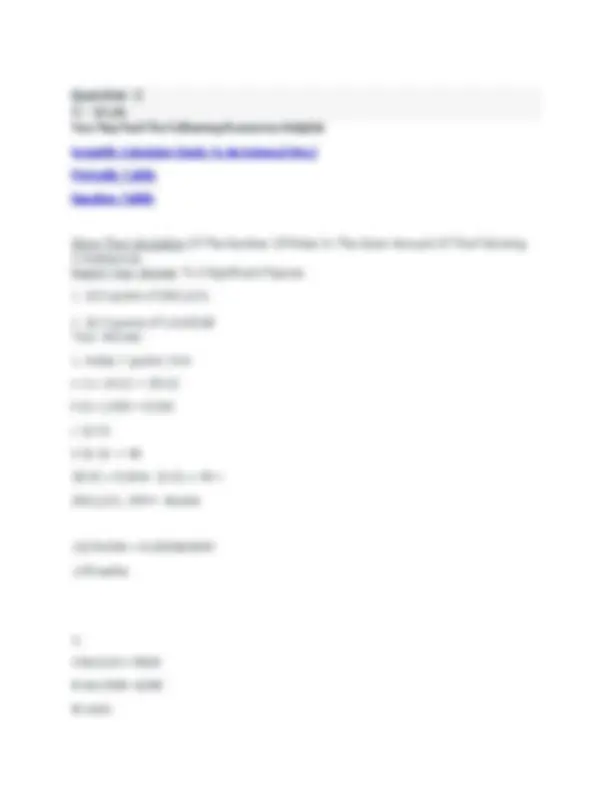
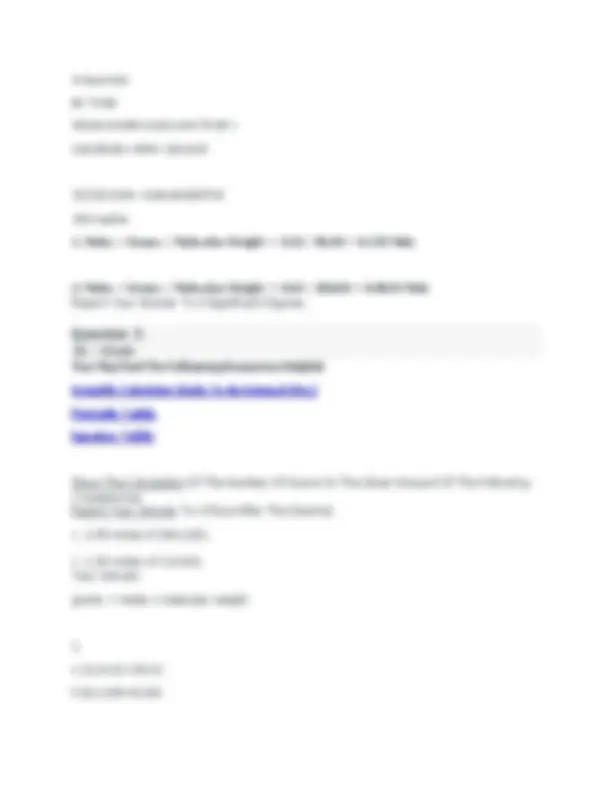
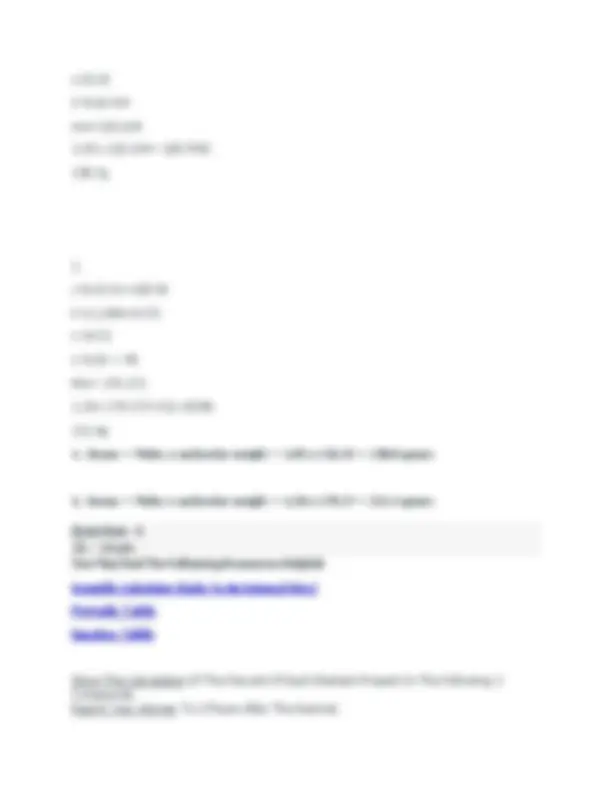

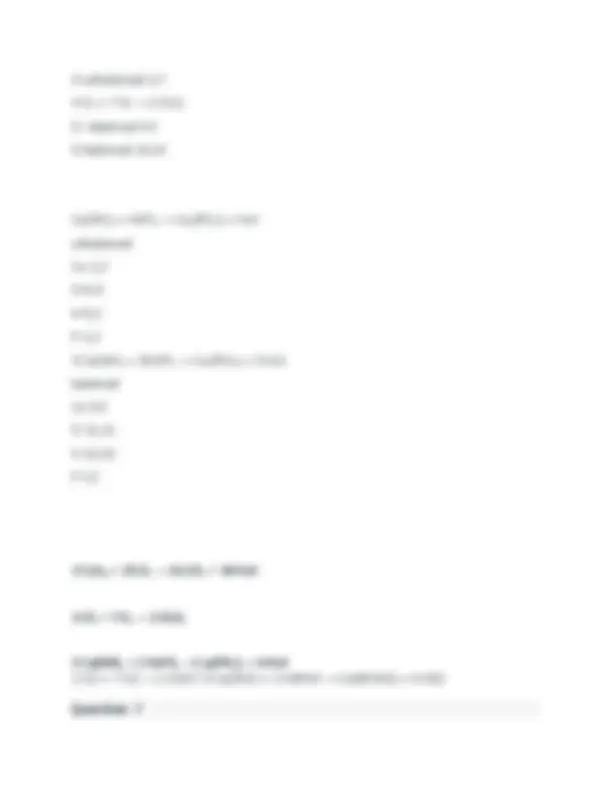
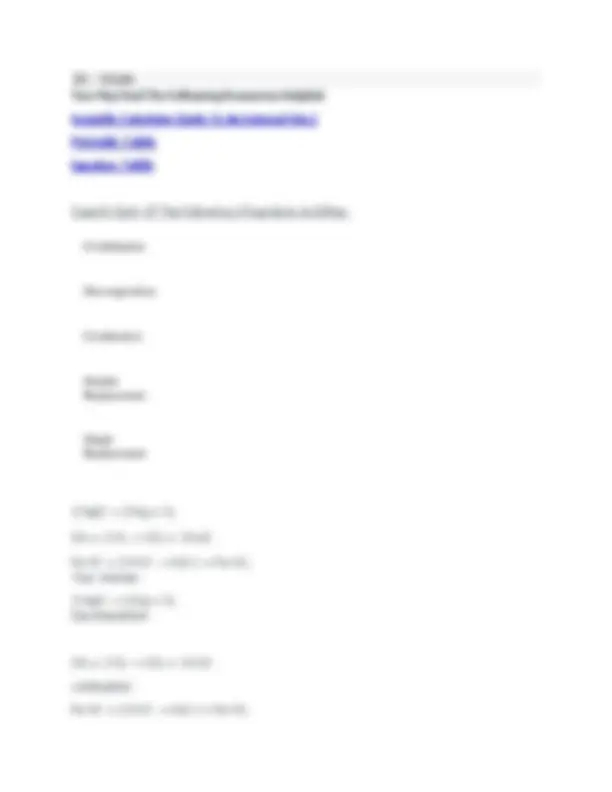
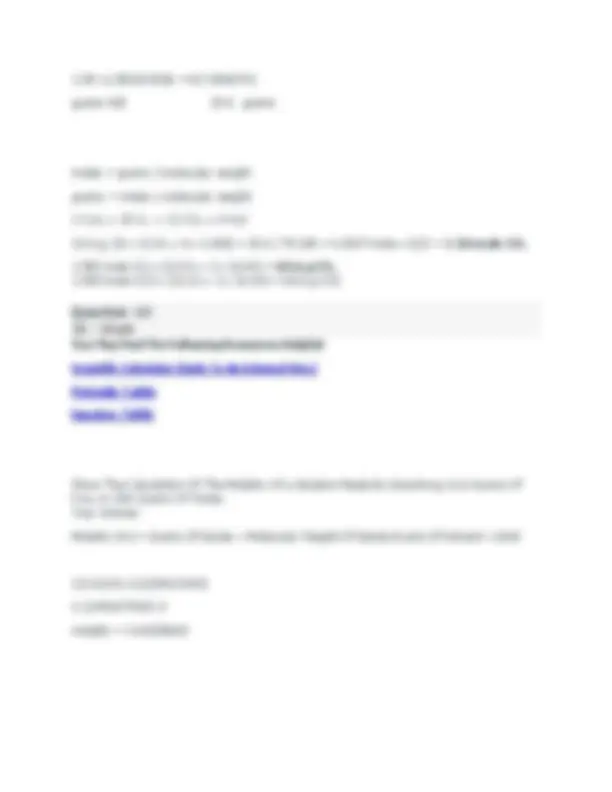



Study with the several resources on Docsity

Earn points by helping other students or get them with a premium plan


Prepare for your exams
Study with the several resources on Docsity

Earn points to download
Earn points by helping other students or get them with a premium plan
Community
Ask the community for help and clear up your study doubts
Discover the best universities in your country according to Docsity users
Free resources
Download our free guides on studying techniques, anxiety management strategies, and thesis advice from Docsity tutors
CHEM 121 MODULE 2 EXAM|| QUESTIONS AND ANSWERS - PORTAGE LEARNING.
Typology: Exams
1 / 14

This page cannot be seen from the preview
Don't miss anything!









Attempt Time Score Latest Attempt 1 120 Minutes 82 Out Of 100
Submitted Jan 8 At 2:07am This Attempt Took 120 Minutes. You May Find The Following Resources Helpful: Scientific Calculator (Links To An External Site.) Periodic Table Equation Table
Show The Calculation Of The Molecular Weight For The Following Two Compounds, Reporting Your Answer To 2 Places After The Decimal.
n 2 x 14.01 = 28. h 8 x 1.008 = 8. c 12. 0 3x 16 = 48 28.02 + 8.064+ 12.01 + 48 = (NH 4 ) 2 CO3 = MW= 96.
C 8x12.01= 98. H 6x1.008= 6. N 14. O 4x16= Br 79. 98.06+6.048+14.01+64+79.90 = C 8 H 6 NO 4 Br= MW= 262. **1. 2N + 8H + C + 3O = 96.
O 4x16= Br 79. 98.06+6.048+14.01+64+79.90 = C 8 H 6 NO 4 Br= MW= 262. 16/262.018= 0. .061 moles
**1. Moles = Grams / Molecular Weight = 13.0 / 96.09 = 0.135 Mole
n 2x14.01=28. h 8x1.008=8.
s 32. 0 4x16= mw=132. 1.05 x 132.104= 138. 138.7g
c 9x12.01=108. h 9.1.008=9. n 14. o 3x16 = 48 Mw= 179. 1.18 x 179.172=211. 211.4g
**1. Grams = Moles x molecular weight = 1.05 x 132.15 = 138.8 grams
%C = 8 x 12.01/260.04 x 100 = 36.95% %H = 6 x 1.008/260.04 x 100 = 2.33% %N = 1 x 14.01/260.04 x 100 = 5.39% %O = 4 x 16.00/260.04 x 100 = 24.61% %Br = 1 x 79.90/260.04 x 100 = 30.73% You May Find The Following Resources Helpful: Scientific Calculator (Links To An External Site.) Periodic Table Equation Table Show The Calculation Of The Empirical Formula For Each Compound Whose Elemental Composition Is Shown Below. 27.60% Mn, 24.17% S, 48.23% O Your Answer: Mn 2 S 3 O 12 27.60% Mn = 54. 27.60/54.94. 0.5023662177 lowest 0.5023662177/0.5023662177 1Mn x2. 24.17% S = 32. 24.17/32.07. 0. 0.7536638603/0.5023662177 1.500227989 1.5 x 48.23% O= 48.23/16. 3. 3.014375/0.5023662177. 6.000353714 6x
27.60% Mn / 54.94 = 0.5024 / 0.5024 = 1 x 2 = 2 24.17% S / 32.07 = 0.7536 / 0.5024 = 1.5 x 2 = 3 48.23% O / 16.00 = 3.0144 / 0.5024 = 6 x 2 = 12 → Mn 2 S 3 O 12 You May Find The Following Resources Helpful: Scientific Calculator (Links To An External Site.) Periodic Table Equation Table Balance Each Of The Following 3 Equations By Placing Coefficients In Front Of Each Substance. C 8 H 18 + O 2 → CO 2 + H 2 O Cl 2 + O 2 → Cl 2 O 7 Ca(OH) 2 + H 3 PO 4 → Ca 3 (PO 4 ) 2 + H 2 O Your Answer: C 8 H 18 + O 2 → CO 2 + H 2 O c-unbalance 8, h-unbalance 18, o-unbalance 2, 3 2 C 8 H 18 + 10 O 2 → 16CO 2 + 18H 2 O c-balanced 16, h-balanced 36, o-balanced 20, Cl 2 + O 2 → Cl 2 O 7 Cl-balanced 2,
2
You May Find The Following Resources Helpful: Scientific Calculator (Links To An External Site.) Periodic Table Equation Table Classify Each Of The Following 3 Reactions As Either: Combination Decomposition Combustion Double Replacement Single Replacement 2 HgO → 2 Hg + O 2 CH 4 + 2 O 2 → CO 2 + 2 H 2 O Fe+2S-^2 + 2 H+Cl-^ → H 2 S ↑ + Fe+2Cl - Your Answer: 2 HgO → 2 Hg + O 2 Decomposition CH 4 + 2 O 2 → CO 2 + 2 H 2 O combustion Fe+2S-^2 + 2 H+Cl-^ → H 2 S ↑ + Fe+2Cl 2 -
2
Double Replacement 2 HgO → 2 Hg + O 2 = Decomposition, One reactant → Two Products CH 4 + 2 O 2 → CO 2 + 2 H 2 O = Combustion, Hydrocarbon + O 2 → CO 2 + H 2 O Fe+2S-^2 + 2 H+Cl-^ → H 2 S ↑ + Fe+2Cl -^ = Double Replacement, 2 ionic → molecular You May Find The Following Resources Helpful: Scientific Calculator (Links To An External Site.) Periodic Table Equation Table Show The Calculation Of The Oxidation Number (Charge) Of Only The Atoms Which Are Changing In The Following Redox Equations And Then Show How They Are Used To Balance The Following Redox Equation. Ca(OH) 2 + NaOH + ClO 2 + C → NaClO 2 + CaCO 3 + H 2 O Your Answer: not enough time Ca (OH) 2 + NaOH + ClO 2 + C → NaClO 2 + CaCO 3 + H 2 O +2 +1-2+ - 2(-4). +1. +2. +(+2)- 2 Ca(OH) 2 + NaOH + ClO 2 + C → NaClO 2 + CaCO 3 + H 2 O ClO 2 : Each O is - 2 (total is - 4), so Cl is + NaClO 2 : Na is metal in group I = +1, each O is - 2 (total is - 4), so Cl is + C: is uncombined so C = 0 CaCO 3 : Ca is metal in group II = +2, each O is - 2 (total is - 6), so C is +
1.58 x1.582424336 =417. grams 418 20.6 grams moles = grams / molecular weight grams = moles x molecular weight 2 C 6 H 6 + 15 O 2 → 12 CO 2 + 6 H 2 O 20.6 g / (6 x 12.01 + 6 x 1.008) = 20.6 / 78.108 = 0.2637 mole x 12/2 = 1.58 mole CO 2 1.582 mole CO 2 x (12.01 + 2 x 16.00) = 69.6 g CO 2 1.582 mole CO2 x (12.01 + 2 x 16.00) = 69.6 g CO You May Find The Following Resources Helpful: Scientific Calculator (Links To An External Site.) Periodic Table Equation Table Show The Calculation Of The Molality Of a Solution Made By Dissolving 12.6 Grams Of Kno 3 In 300 Grams Of Water. Your Answer: Molality (m) = Grams Of Solute ÷ Molecular Weight Of Solute Grams Of Solvent ÷ (12.6/101.11)/(300/1000) 0.124616754/0. molality = 0.